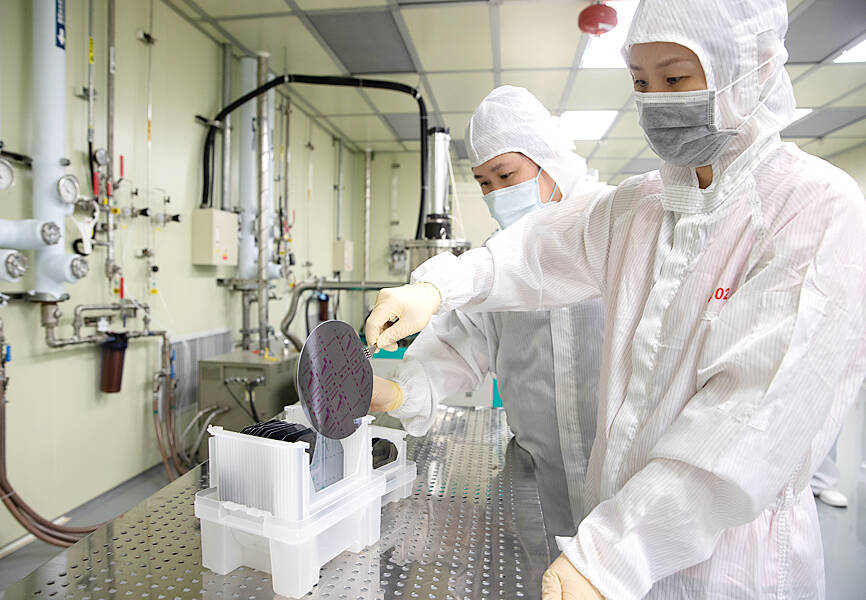About 58 percent of semiconductors imported by Japan last year came from Taiwan, an increase of 2.5 percentage points from 2021, the Ministry of Economic Affairs said on Thursday.
The value of Taiwan’s semiconductor exports to Japan reached US$15.78 billion, up 32.7 percent annually, the ministry said in a statement.
Taiwan’s position as the top supplier of semiconductors to Japan put it well ahead of its nearest competitors, with the US holding an 8.5 percent share, China 8.3 percent and South Korea 7.5 percent.

Photo: CNA
The increase in exports to Japan reflects robust demand for specialty ICs and chips used in automotive electronics, the ministry said.
Semiconductors accounted for 47 percent of Taiwan’s total exports to Japan last year, which totaled US$33.61 billion, it said.
However, the pace of growth in exports to Japan fell to 15.1 percent annually, from 24.8 percent in 2021.
The ministry attributed the muted growth to geopolitical conflicts and rising inflation worldwide.
Last year, Taiwan was also Japan’s No. 1 supplier of storage media and polyformaldehyde products.
Storage media exports from Taiwan to Japan totaled US$1.08 billion, translating into a 29.8 percent share of Japan’s imports, ahead of China’s 22.5 percent share, South Korea’s 16.7 percent and the US’ 5.9 percent.
Exports of polyformaldehyde products to Japan totaled US$940 million, accounting for 34.7 percent of the country’s imports, ahead of Thailand’s 12.5 percent share, South Korea’s 12.3 percent and China’s 11.5 percent.
Taiwan sold US$620 million of computer and related devices to Japan last year, accounting for 4.1 percent of Japan’s total imports and becoming the third-largest supplier, after China at 76.5 percent and Singapore at 4.6 percent.
Meanwhile, Taiwan imported US$54.6 billion of goods from Japan last year, down 2.7 percent from a year earlier.
IC products were the most popular import from Japan, accounting for 17.1 percent of overall imports, but saw an annual decline of 8.7 percent, falling to US$9.36 billion, due to falling demand for memory chips, the ministry said.
Semiconductor equipment imports from Japan hit US$6.7 billion, up 10.8 percent from a year earlier and making up 12.3 percent of Taiwan’s total imports from Japan, it added.
Imports of wafers used in semiconductor production from Japan totaled US$1.69 billion, an annual increase of 17.4 percent and accounting for 3.1 percent of Taiwan’s overall purchases from Japan, the ministry said.
Japan was the largest wafer supplier to Taiwan last year, with sales accounting for 45.9 percent of Taipei’s total purchases, ahead of China with 21.9 percent, Germany with 8 percent and Singapore with 6.4 percent, it said.
The Netherlands was the largest supplier of semiconductor equipment to Taiwan with a 29 percent share last year, followed by Japan with a 23.1 percent share and the US with 20.9 percent, the ministry said.
China was the largest IC supplier to Taiwan, providing 29.1 percent of Taiwan’s total purchases, ahead of South Korea with 26.3 percent and Japan with 12.7 percent, it added.

Taiwan Semiconductor Manufacturing Co (TSMC, 台積電) yesterday said that its investment plan in Arizona is going according to schedule, following a local media report claiming that the company is planning to break ground on its third wafer fab in the US in June. In a statement, TSMC said it does not comment on market speculation, but that its investments in Arizona are proceeding well. TSMC is investing more than US$65 billion in Arizona to build three advanced wafer fabs. The first one has started production using the 4-nanometer (nm) process, while the second one would start mass production using the

A TAIWAN DEAL: TSMC is in early talks to fully operate Intel’s US semiconductor factories in a deal first raised by Trump officials, but Intel’s interest is uncertain Broadcom Inc has had informal talks with its advisers about making a bid for Intel Corp’s chip-design and marketing business, the Wall Street Journal reported, citing people familiar with the matter. Nothing has been submitted to Intel and Broadcom could decide not to pursue a deal, according to the Journal. Bloomberg News earlier reported that Taiwan Semiconductor Manufacturing Co (TSMC, 台積電) is in early talks for a controlling stake in Intel’s factories at the request of officials at US President Donald Trump’s administration, as the president looks to boost US manufacturing and maintain the country’s leadership in critical technologies. Trump officials raised the

‘SILVER LINING’: Although the news caused TSMC to fall on the local market, an analyst said that as tariffs are not set to go into effect until April, there is still time for negotiations US President Donald Trump on Tuesday said that he would likely impose tariffs on semiconductor, automobile and pharmaceutical imports of about 25 percent, with an announcement coming as soon as April 2 in a move that would represent a dramatic widening of the US leader’s trade war. “I probably will tell you that on April 2, but it’ll be in the neighborhood of 25 percent,” Trump told reporters at his Mar-a-Lago club when asked about his plan for auto tariffs. Asked about similar levies on pharmaceutical drugs and semiconductors, the president said that “it’ll be 25 percent and higher, and it’ll

CHIP BOOM: Revenue for the semiconductor industry is set to reach US$1 trillion by 2032, opening up opportunities for the chip pacakging and testing company, it said ASE Technology Holding Co (日月光投控), the world’s largest provider of outsourced semiconductor assembly and test (OSAT) services, yesterday launched a new advanced manufacturing facility in Penang, Malaysia, aiming to meet growing demand for emerging technologies such as generative artificial intelligence (AI) applications. The US$300 million facility is a critical step in expanding ASE’s global footprint, offering an alternative for customers from the US, Europe, Japan, South Korea and China to assemble and test chips outside of Taiwan amid efforts to diversify supply chains. The plant, the company’s fifth in Malaysia, is part of a strategic expansion plan that would more than triple